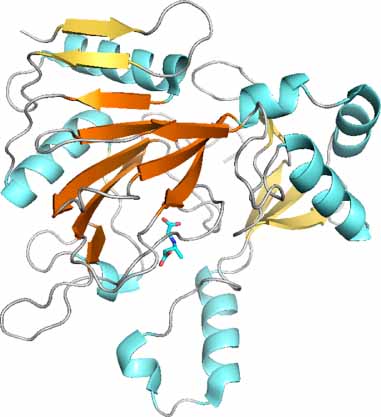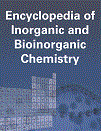Iron and 2-Oxoglutarate-Dependent Isonitrile-Forming Enzymes
Tzu-Yu Chen
Department of Chemistry, North Carolina State University, Raleigh, North Carolina, 27695 USA
Search for more papers by this authorYisong Guo
Department of Chemistry, Carnegie Mellon University, Pittsburgh, Pennsylvania, 15213 USA
Search for more papers by this authorWei-chen Chang
Department of Chemistry, North Carolina State University, Raleigh, North Carolina, 27695 USA
Search for more papers by this authorTzu-Yu Chen
Department of Chemistry, North Carolina State University, Raleigh, North Carolina, 27695 USA
Search for more papers by this authorYisong Guo
Department of Chemistry, Carnegie Mellon University, Pittsburgh, Pennsylvania, 15213 USA
Search for more papers by this authorWei-chen Chang
Department of Chemistry, North Carolina State University, Raleigh, North Carolina, 27695 USA
Search for more papers by this authorAbstract
The isonitrile moiety, composed of an NC connection, is a commonly used functional group in chemical synthesis due to its highly reactive nature toward nucleophile, electrophile, and radical. Isonitrile-containing natural products have shown diverse biological properties including virulence, antimicrobial activities, and metal acquisition. Despite its abundance in natural products, how isonitrile is introduced remains understudied. Recently, N -glycinyl moiety has been identified as a biosynthon for isonitrile wherein several nonheme iron and 2-oxoglutarate-dependent (Fe/2OG) enzymes have been identified to enable this reaction. Distinct from canonical oxygenation or halogenation catalyzed by Fe/2OG enzymes, installation of the isonitrile group from a glycinyl moiety is a four-electron oxidation of the substrate and involves decarboxylation-assisted desaturation, thus representing an uncommon reaction type. To elucidate plausible reaction mechanism, several Fe/2OG-dependent enzymes involved in isonitrile-containing peptides and polyketides were characterized. Combining mechanistic probes design, protein X-ray crystallography, biochemical and biophysical characterizations, and mutagenesis, a plausible reaction pathway was established. Formation of isonitrile involves two sequential reactions. Following a CH bond cleavage triggered by an Fe(IV)-oxo, a carboxyaldimine species is produced in the first reaction. In the second reaction, decarboxylation-assisted desaturation of the carboxyaldimine intermediate affords the NC moiety.
3D Structure
References
- 1 W DeLano , The PyMOL Molecular Graphics System , DeLano Scientific , San Carios, CA ( 2002 ).
- 2 JC Price , EW Barr , B Tirupati , JM Bollinger Jr and C Krebs , Biochemistry , 42 , 7497 – 508 ( 2003 ).
- 3 W-C Chang , J Li , JL Lee , AA Cronican and Y Guo , J Am Chem Soc , 138 , 10390 – 3 ( 2016 ).
- 4
JM Bollinger Jr
W-C Chang
,
ML Matthews
,
RJ Martinie
,
AK Boal
and
C Krebs
, in
C Schofield
and
R Hausinger
(eds.),
2-Oxoglutarate-Dependent Oxygenases
,
Royal Society of Chemistry
, pp
95
–
122
(
2015
).
10.1039/9781782621959-00095 Google Scholar
- 5 CJ Thibodeaux , W-C Chang and H-W Liu , Chem Rev , 112 , 1681 – 709 ( 2012 ).
- 6 LF Wu , S Meng and GL Tang , Biochim Biophys Acta , 1864 , 453 – 70 ( 2016 ).
- 7 MS Islam , TM Leissing , R Chowdhury , RJ Hopkinson and CJ Schofield , Annu Rev Biochem , 87 , 585 – 620 ( 2018 ).
- 8 SS Gao , N Naowarojna , R Cheng , X Liu and P Liu , Nat Prod Rep , 35 , 792 – 837 ( 2018 ).
- 9 TY Chen , J Chen , Y Tang , J Zhou , Y Guo and W-C Chang , Chin J Chem , 39 , 463 – 72 ( 2021 ).
- 10
RP Hausinger
, in
C Schofield
and
R Hausinger
(eds.),
2-Oxoglutarate-Dependent Oxygenases
,
Royal Society of Chemistry
, pp
1
–
58
(
2015
).
10.1039/9781782621959-00001 Google Scholar
- 11 S Martinez and RP Hausinger , J Biol Chem , 290 , 20702 – 11 ( 2015 ).
- 12 H Nakamura , Y Matsuda and I Abe , Nat Prod Rep , 35 , 633 – 45 ( 2018 ).
- 13 L Wang , M Zhu , Q Zhang , X Zhang , P Yang , Z Liu , Y Deng , Y Zhu , X Huang , L Han , S Li and J He , ACS Chem Biol , 12 , 3067 – 75 ( 2017 ).
- 14 NC Harris , M Sato , NA Herman , F Twigg , W Cai , J Liu , X Zhu , J Downey , R Khalaf , J Martin , H Koshino and W Zhang , Proc Natl Acad Sci USA , 114 , 7025 – 30 ( 2017 ).
- 15 NC Harris , DA Born , W Cai , Y Huang , J Martin , R Khalaf , CL Drennan and W Zhang , Angew Chem Int Ed , 57 , 9707 – 10 ( 2018 ).
- 16 T-Y Chen , J Chen , Y Tang , J Zhou , Y Guo and W-C Chang , Angew Chem Int Ed Engl , 59 , 7367 – 71 ( 2020 ).
- 17 T-Y Chen , Z Zheng , X Zhang , J Chen , L Cha , Y Tang , Y Guo , J Zhou , B Wang , H-W Liu and W-C Chang , ACS Catal , 12 , 2270 – 9 ( 2022 ).
- 18 A Del Rio Flores , DW Kastner , Y Du , M Narayanamoorthy , Y Shen , W Cai , V Vennelakanti , NA Zill , LB Dell , R Zhai , HJ Kulik and W Zhang , J Am Chem Soc ( 2022 ).
- 19 G Pishchany , E Mevers , S Ndousse-Fetter , DJ Horvath Jr CR Paludo , EA Silva-Junior , S Koren , EP Skaar , J Clardy and R Kolter , Proc Natl Acad Sci USA , 115 , 10124 – 9 ( 2018 ).
- 20
A Dömling
and
I Ugi
,
Angew Chem Int Ed
,
39
,
3168
–
210
(
2000
).
10.1002/1521-3773(20000915)39:18<3168::AID-ANIE3168>3.0.CO;2-U CAS PubMed Web of Science® Google Scholar
- 21 RM Wilson , JL Stockdill , X Wu , X Li , PA Vadola , PK Park , P Wang and SJ Danishefsky , Angew Chem Int Ed , 51 , 2834 – 48 ( 2012 ).
- 22 B Zhang and A Studer , Chem Soc Rev , 44 , 3505 – 21 ( 2015 ).
- 23 M Giustiniano , A Basso , V Mercalli , A Massarotti , E Novellino , GC Tron and J Zhu , Chem Soc Rev , 46 , 1295 – 357 ( 2017 ).
- 24 MJ Schnermann and RA Shenvi , Nat Prod Rep , 32 , 543 – 77 ( 2015 ).
- 25 A Massarotti , F Brunelli , S Aprile , M Giustiniano and GC Tron , Chem Rev , 121 , 10742 – 88 ( 2021 ).
- 26 K Mehdiratta , S Singh , S Sharma , RS Bhosale , R Choudhury , DP Masal , A Manocha , BD Dhamale , N Khan , V Asokachandran , P Sharma , M Ikeh , AC Brown , T Parish , AK Ojha , JS Michael , M Faruq , GR Medigeshi , D Mohanty , DS Reddy , VT Natarajan , SS Kamat and RS Gokhale , Proc Natl Acad Sci USA , 119 , e2110293119 ( 2022 ).
- 27 JA Buglino , Y Ozakman , Y Xu , F Chowdhury , DS Tan and MS Glickman , MBio , 13 , e0251322 ( 2022 ).
- 28 WL Parker , ML Rathnum , JH Johnson , JS Wells , PA Principe and RB Sykes , J Antibiot , 4 , 454 – 60 ( 1988 ).
- 29 G Ernouf , IK Wilt , S Zahim and WM Wuest , ChemBioChem , 19 , 2448 – 52 ( 2018 ).
- 30 P Imming , R Mohr , E Muller , W Overheu and G Seitz , Angew Chem Int Ed Engl , 21 , 284 ( 1982 ).
- 31 YB Huang , W Cai , A Del Rio Flores , FF Twigg and W Zhang , Anal Chem , 92 , 599 – 602 ( 2020 ).
- 32 M Dei Cas , R Paroni , A Saccardo , E Casagni , S Arnoldi , V Gambaro , M Saresella , C Mario , F La Rosa , I Marventano , F Piancone and G Roda , J Chromatogr B Analyt Technol Biomed Life Sci , 1154 , 121982 ( 2020 ).
- 33 EG Pavel , J Zhou , RW Busby , M Gunsior , CA Townsend and EI Solomon , J Am Chem Soc , 120 , 743 – 53 ( 1998 ).
- 34 MJ Ryle , P Padmakumar and RP Hausinger , Biochemistry , 38 , 15278 – 86 ( 1999 ).
- 35 KA Johnson , ZB Simpson and T Blom , Anal Biochem , 387 , 20 – 9 ( 2009 ).




